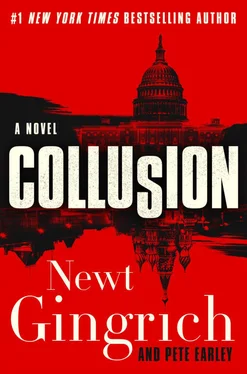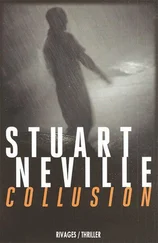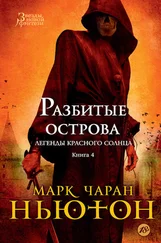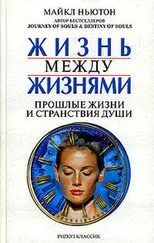A few under-the-breath but audible whew s.
“To summarize,” Director Davidson said, “we have a twenty-six-year-old woman from an incredibly wealthy family with strong political connections. She has no history of criminal activity and neither she nor her family has any interest in being questioned about her dead French terrorist ‘acquaintance.’” He stood. “The family already has hired a team of Washington lawyers to prevent us from interviewing Aysan Rivera. I have a meeting with the attorney general. Sally will take the point on the agency’s role in the ongoing Kiev investigation.”
North spoke for a few minutes after Davidson was gone, then asked Mayberry to stay behind while everyone else left.
“Valerie, I want you to go after Aysan Rivera. Be discreet.”
“What’s that mean, exactly?”
“Undercover. Befriend her. You’re rich. She’s rich. You just happen to bump into her. Off the books. A convenient coincidence. Get her to talk about De Depardieu.”
“Rich families do background checks when someone suddenly pops up in their social circle, especially when their daughter is under suspicion of bedding a terrorist.”
“Your family is well known. You’re legit. You can walk the walk.”
Mayberry was quiet for a moment. “What was Brett Garrett doing in Kiev?”
“You recognized him.”
“Anyone who didn’t should be fired. Is Garrett working for the agency or was he there as an actual security guard?”
“Why don’t you ask him?” North said. “He’s scheduled to land here later today. See what you can get out of him about the Kiev shooting. Human intel is always better than security footage.”
With his right hand, Brett Garrett gently ran his fingers across his left side, moving downward under his armpit to his hip. Even through his plaid flannel shirt, he could feel the bumpy scars. Was there anything more painful than being burned? In the old days, medics had jabbed a shot of morphine into a wounded soldier. In 2011, the military began using a new wonder drug. “The lollipop.” Such an innocent name. Medically OTFC. An acronym for oral transmucosal fentanyl citrate, 400 micrograms on a white stick that indeed was a lollipop.
“The fentanyl lollipop offers our medics a faster way to ease the pain of a battlefield injury because the drug can be absorbed more rapidly through a lozenge in the mouth than from a needle injected into a muscle,” the Pentagon announced.
Apparently, no one had paid attention to its key ingredient: fentanyl. Only after the national opioid epidemic erupted had that drug become familiar to the public.
He turned uncomfortably in the narrow seat of the KLM Airbus A330 about to touch down at Dulles International Airport, west of downtown Washington, D.C. He’d never been afraid of dying. What was the phrase? Some run away, while others run forward. He’d not been afraid when Senator Cormac Stone had ordered him to appear before Congress for a predetermined public humiliation about Cameroon. But the intense, physical craving, the constant need for painkillers, that had broken him.
Garrett unbuckled his seat belt so he could reach into the front right pocket of his denim jeans while sitting and withdraw his prescription. Two thin pieces of film quickly tucked under the tongue. Not fentanyl. Suboxone. The bitch’s twin. The unintentional addict’s pharmacological best friend. Buprenorphine and naloxone. It was supposed to offer salvation for the opioid addiction created during his months of hospitalization at Walter Reed Medical Center for treatment of burns and bullet wounds. The bullet holes had healed, and so had the burned skin. But his need for powerful painkillers had lingered. Suboxone was his best shot at getting clean, but he was still weaning and privately unsure if the cravings would ever end. It had started with a medic sticking a cute lollipop into his mouth while being airlifted out of Cameroon.
Relief.
Garrett always traveled light. Everything he needed, with one exception, was inside the backpack stored in the aircraft’s overhead bin above him. His SIG Sauer P226 pistol was the exception. Most others had switched to Glock 19s, but the SIG had been a gift from Garrett’s Navy SEAL instructor, a master chief petty officer—the same one who had given him the hated nickname Hillbilly. It had been the instructor’s last SEAL class. Retirement. The SIG had been his combat weapon. Handed down with much respect. Garrett preferred a weapon that had already drawn blood. A buddy who flew military transport planes to Joint Air Base Andrews had promised to deliver it stateside. Garrett was traveling commercial. Too much hassle to explain it.
Garrett was coming home, but he didn’t think of it like that. More like returning to a base camp. He’d bought a one-bedroom condo in Rosslyn not far from a metro stop. Two suits, one black, one gray, both off-the-rack, hung in its closet. Five collared shirts—three whites, two light blue. One tie. Red. Running gear, several pairs of denim jeans, T-shirts, boxers, and military fatigues. No car, but he owned a Norton Commando Interpol motorcycle—made in 1975 by the Brits for police use only. He’d recovered it from a barn in Belgium and personally rebuilt it. His daddy had taught him about engines and motorcycles, just like his daddy had taught him about shooting.
The Norton helped him unwind. When Garrett couldn’t sleep, when the memories, second-guessing, and cravings became too much, he’d ride west at night along Highway 50 until he reached the right turn just outside Aldie, Virginia, onto the Snickersville Turnpike—although calling that winding bit of unmarked asphalt a turnpike was a grand embellishment. The two-way weaved through scenic Virginia hills that took travelers across a 180-plus-year-old stone bridge that enemies Robert E. Lee and “Fighting Joe” Hooker had both crossed at times. It wasn’t Civil War history that called him. In a vanishing countryside being overrun with subdivided tract houses, Snickersville was one of the last rural stretches still defined by waist-high stone walls and pastures. There were no stoplights. As he leaned into the curves, the Norton’s headlight would cast its beam only twenty yards into the curving blackness. Glowing eyes. A scampering raccoon. A fear-frozen deer. No time to react. No time for error. That was when the music started, as his favorite author, Hunter S. Thompson, had described it. The dance with fate. Pushing life to its edge. A patch of sand. A greasy spot. The slightest miscalculation. Catastrophe. Was he suicidal? No, it was a way for him to become completely focused. To drive out the distracting demons. The second-guessing that never ended. Some nights Garrett couldn’t say. Maybe it was suicidal. All he knew was he could sleep soundly after those late-night runs. He could momentarily forget the brown tabs now dissolving under his tongue and the dishonorable-discharge papers that he kept at the bottom of a foot locker in his condo closet.
Besides the Norton, Garrett’s other prized possessions were tools of his craft. A stainless-steel, nearly indestructible watch fitted on his wrist with a compass and altimeter and water resistant to a thousand feet. Behind a false closet wall in his condo, sixteen high-quality firearms, ranging from a modified M79 40 mm grenade launcher to a sniper’s Mark 12 Mod 0/1 Special Purpose Rifle to a semicompact polymer Jericho 941 semi-auto pistol—a gift from a Mossad officer. He also owned a Glock 19, just because.
“Coming home?” the woman next to him asked as the KLM’s wheels touched down on the Dulles runway. Garrett guessed she was eighty, with gray hair coiled tightly into a bun.
“No,” he replied in a kind voice. “I’m from Arkansas.” It wasn’t a lie, although he’d not lived in that state since graduating from high school. The DMV—shorthand for the District, Maryland, and Virginia metro area—was considered a stopover for many who lived there—even those who’d spent decades in Washington.
Читать дальше











